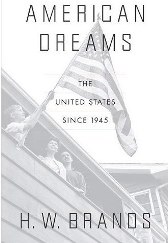
American Dreams: The United States Since 1945
by H.W. Brands
–Reviewed by Adam Fleisher
 H.W. Brands, a professor of history at the University of Texas at Austin, charges through sixty-plus years of political, cultural, social, and economic history in this relatively brief yet very broad survey of post-war America; think Billy Joel’s “We Didn’t Start the Fire” as a narrative history. As the title would imply, Brands traces the evolution of dreams from the wake of World War II – when Americans believed in the collective power of the nation to transform the world – to today, when individual dreams of making better lives for ourselves and our children flourish, even as collective national dreams have run aground.
H.W. Brands, a professor of history at the University of Texas at Austin, charges through sixty-plus years of political, cultural, social, and economic history in this relatively brief yet very broad survey of post-war America; think Billy Joel’s “We Didn’t Start the Fire” as a narrative history. As the title would imply, Brands traces the evolution of dreams from the wake of World War II – when Americans believed in the collective power of the nation to transform the world – to today, when individual dreams of making better lives for ourselves and our children flourish, even as collective national dreams have run aground.
Starting with the test of the atomic bomb at Alamogordo and victory in World War II, Brands finds the U.S. on constant war footing, a symptom perhaps of that collective dream of transformation. The Cold War began immediately, and though it was not a “war effort” per se, it was an effort of similar organizing and centralizing force in the name of national security. The concept of security ballooned – state’s righters even embraced President Eisenhower’s national highway system, a massive expansion of federal power, in its name. At the end of the Cold War we entered quickly into a new war. The effort to expel Saddam Hussein from Kuwait “came as a shock,” and we forget how close the vote was: the resolution passed the Senate 52 to 47. The 1990s were marked by foreign incursions until 9/11 launched us into two wars. The power and size of the state grew dramatically in the sixty years Brands covers, but its ability to deliver did not.
But as state ambitions grew, baby boomers and the Civil Rights movement also transformed the relationship between individuals and institutions in the country, Brands argues. The Baby Boom generation “prompted a reorientation of American culture” in a post-war world where families had more time and more money to spend on children. The robust economy improved the quality of middle-class life. Federally subsidized mortgages and cookie-cutter building techniques made the paradigmatic suburban life possible. Air conditioning made the sunbelt livable, Brands argues, spurring a huge demographic shift that thinned the northern states – which became more identifiably Democratic as a region – and populated the South, which became a formidable conservative bloc. The dark side of the suburban dream, Brands notes, was the “stultifying” nature of living in virtual isolation in “bedroom” communities that lived down to their description. Still, people had time and money, and an entertainment industry, from Disneyland to spectator sports, arose to answer their urges.
While many Americans suffered from too much house, southern blacks still faced vicious racism. Television, according to Brands, helped the Civil Rights movement by making the prejudice and violence of the south vivid and real for the rest of the country. During the Montgomery Bus Boycott, viewers saw the black community walking to work as “half-empty buses drove uncaringly by.” And television captured the cruelty unleashed by Bull Connor during protests in Birmingham, surprising even Martin Luther King and sickening President Kennedy. The movement – and its televised version – culminated in the Civil Rights Act and Lyndon Johnson’s War on Poverty.
Brands runs through more recent events just as quick and broadly. The pace of the narrative makes the country’s reversals of fortune stand out. Political sentiments shifted enough to make Ronald Reagan’s 1984 defeat of Walter Mondale as striking as Lyndon Johnson’s defeat of Barry Goldwater two decades earlier. The U.S. used oil as a weapon against the British during the Suez Crisis; a generation later, the U.S. was the one suffering from an embargo. And the only thing more striking than the horror of the AIDS epidemic was that it became a treatable disease in the same decade.
American Dreams can feel like a mad dash – offering intriguing theories without elaboration, making occasional incongruous leaps. But for the most part, Brands hews to the notion of the individual and the collective – he even seems disinterested in distinctions among political ideologies. What interests Brands, and what prevents this book from being a succession of narrative historical vignettes, is the matter of how Americans have managed to create opportunities for themselves by consistently believing that they were there for the taking.
Excerpt: “At times CNN complemented or even replaced traditional means of diplomatic communication. In the weeks before the Persian Gulf War, as the Security Council’s deadline for an Iraqi withdrawal from Kuwait approached, Saddam Hussein conducted his diplomacy via interviews and speeches he knew CNN would carry to American households, including the White House. In the summer of 1991 the Bush administration followed the attempted coup against Mikhail Gorbachev not by means of the CIA but through CNN. ‘The live CNN pictures are stark,’ Bush wrote in his diary. ‘Bumper to bumper APCs’ – armored personnel carriers – ‘parked in Moscow. Tanks moving down the streets.’”
Further Reading: Freedom Just Around the Corner: A New American History: 1585-1828 by Walter A. McDougall and The Seventies: The Great Shift in American Culture, Society, and Politics
by Bruce Schulman
Adam Fleisher is a law student at the University of Virginia.
*Photo courtesy delbz.




Send A Letter To the Editors